
Lake Zurich is a lake in Switzerland, extending southeast of the city of Zurich. Depending on the context, Lake Zurich or Zürichsee can be used to describe the lake as a whole, or just that part of the lake downstream of the Hurden peninsula and Seedamm causeway. In the latter case, the upstream part of the lake is called Obersee, whilst the lower part is sometimes also referred to as the Lower Lake, respectively.
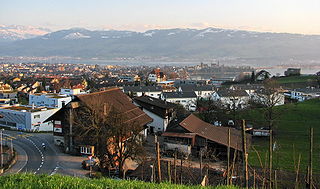
Rapperswil-Jona is a municipality in the Wahlkreis (constituency) of See-Gaster in the canton of St. Gallen in Switzerland. Besides Rapperswil and Jona, which were separate municipalities until 2006, Rapperswil-Jona also includes Bollingen, Busskirch, Curtiberg, Kempraten-Lenggis, and Wagen.

Wurmsbach Abbey is a monastery of Cistercian nuns located in Bollingen, a locality of Rapperswil-Jona, in the Canton of St. Gallen, Switzerland. It is located on the north shore of upper Lake Zürich. The house is a part of the Order of Cistercians of the Common Observance (O.Cist.).

Lützelau is an island located, with the neighbouring island of Ufenau, in Lake Zürich in Switzerland between Rapperswil and Freienbach.

Jona is a former municipality and since January 2007 part of the municipality of Rapperswil-Jona in the Wahlkreis (constituency) of See-Gaster in the canton of St. Gallen in Switzerland. Before the merger with Rapperswil, the former municipality of Jona comprised the villages of Jona, Bollingen, Busskirch, Curtiberg, Kempraten-Lenggis, and Wagen.

Rapperswil is a former municipality and since January 2007 part of the municipality of Rapperswil-Jona in the Wahlkreis (constituency) of See-Gaster in the canton of St. Gallen in Switzerland, located between Obersee and the main part of Lake Zurich.
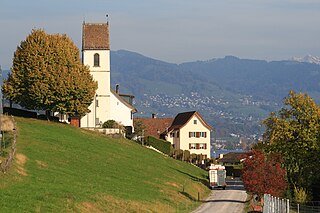
Bollingen is a village (Kirchdorf) within the municipality of Rapperswil-Jona in the Swiss canton of St. Gallen.
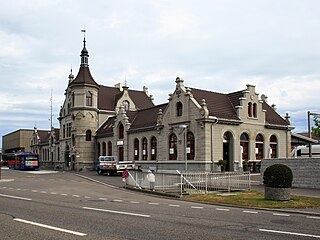
Rapperswil railway station is located next to the old town and harbour of Rapperswil in the Swiss canton of St. Gallen. It is the largest of four active railway stations in the municipality of Rapperswil-Jona. Rapperswil railway station is situated on the north shore of Lake Zürich at the northern end of the Seedamm, which separates the Obersee from the main body of the lake.

Heilig Hüsli is a bridge chapel in Rapperswil, Canton of St. Gallen, Switzerland.
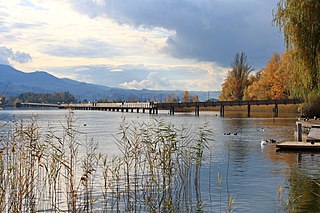
Holzbrücke Rapperswil-Hurden is a wooden pedestrian bridge between the city of Rapperswil and the village of Hurden crossing the Obersee in Switzerland. On 6 April 2001, the footbridge was opened. With a length of 841 metres (2,759 ft) it is the longest wooden bridge in Switzerland.

Hurden is a village in the municipality of Freienbach in the canton of Schwyz in Switzerland. First mentioned in 1217, the name "de Hurden" was used for the peninsula and for the fish traps made of woven work, called "Hürden" or "Hurden", which were used by the locals.

The Obersee is the smaller of the two parts of Zürichsee in the cantons of St. Gallen and Schwyz in Switzerland.

Centum Prata is the name of a Roman vicus, whose remains are located on the eastern Zürichsee lakeshore in Kempraten, a locality of the municipality Rapperswil-Jona in the canton of St. Gallen in Switzerland. Centum Prata is the most important archaeological site from the Gallo-Roman era in the canton of St. Gallen.

The Grynau Castle is the name of a castle tower in the municipality of Tuggen in the canton of Schwyz, built by the House of Rapperswil in the early 13th century AD.

Buechberg is an elongated molasse hill in the Swiss cantons of Schwyz and St. Gallen on Obersee lakeshore.

The Rapperswil–Ziegelbrücke railway line is a single-track standard-gauge railway line in Switzerland. It was built as part of the route from Rüti to Glarus, which was opened by the United Swiss Railways on 15 February 1859.

The S4 is a railway service of the St. Gallen S-Bahn that provides hourly service between Sargans and Rapperswil via St. Gallen, connecting stations in the cantons of St. Gallen and Appenzell Ausserrhoden. The section near Lake Constance is also part of the Bodensee S-Bahn. Südostbahn (SOB), a private company primarily owned by the federal government and the canton of St. Gallen, operates the service.

The S17 is a railway service of the St. Gallen S-Bahn that provides hourly service between Sargans and Rapperswil, connecting stations in the cantons of St. Gallen and Glarus. Südostbahn (SOB), a private company primarily owned by the federal government and the canton of St. Gallen, operates the service.
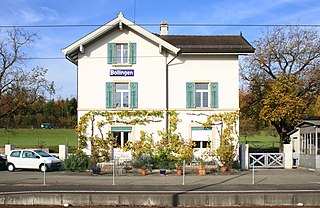
Bollingen railway station was until 2004 a railway station in the municipality of Rapperswil-Jona in the canton of St. Gallen, Switzerland. It is located about 1 km (0.62 mi) west of the village of Bollingen on the Rapperswil–Ziegelbrücke railway line, between Blumenau and Schmerikon.































